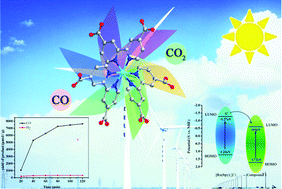Synthesis and CO2 photoreduction of two 3d–4f heterometal–organic frameworks†
Abstract
Two 3d–4f heterometal–organic frameworks are synthesized by a steam-assisted conversion method and are characterized by single-crystal X-ray diffraction, PXRD, IR, TG, and UV–vis spectroscopy. Compounds 1 and 2 have similar structures, in which binuclear gadolinium clusters are connected by [M(BPDC)3] (M = Ni for 1 and Co for 2) secondary building units (SBUs) and extend into 3D frameworks with pcu topologies. In addition, we have also investigated the photoreduction of CO2 under visible light. The CO yields reached 7622 μmol−1 g−1 and 11 250 μmol−1 g−1 with 1 and 2 as catalysts, respectively, and ruthenium pyridine as the photosensitizer after two hours of visible light irradiation. Both of them have high selectivity values for CO, reaching 94.85% for 1 and 94.46% for 2. Furthermore, the catalytic mechanism is proposed through a photoelectrochemical test. This study provides a feasible strategy for the design of efficient CO2 photocatalysts with a high charge separation rate.



 Please wait while we load your content...
Please wait while we load your content...